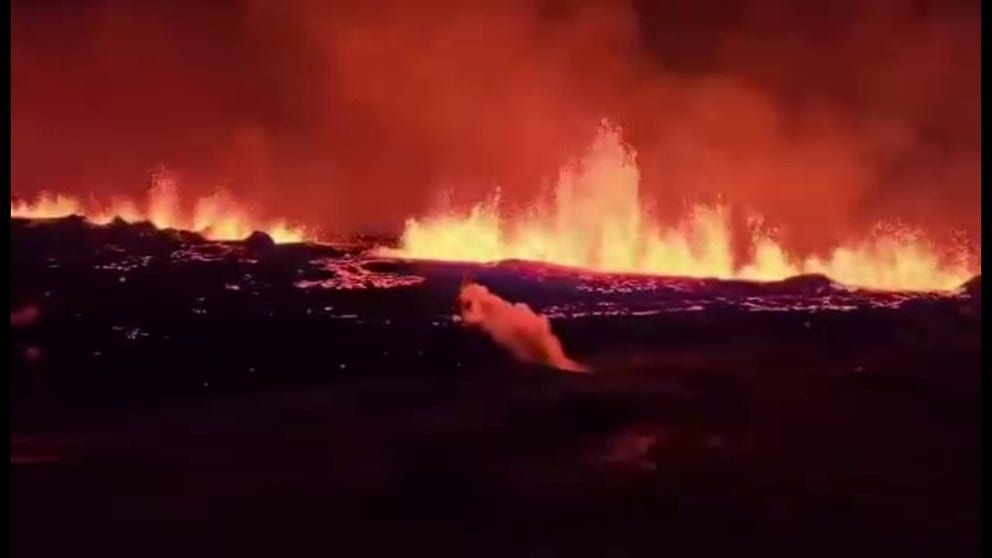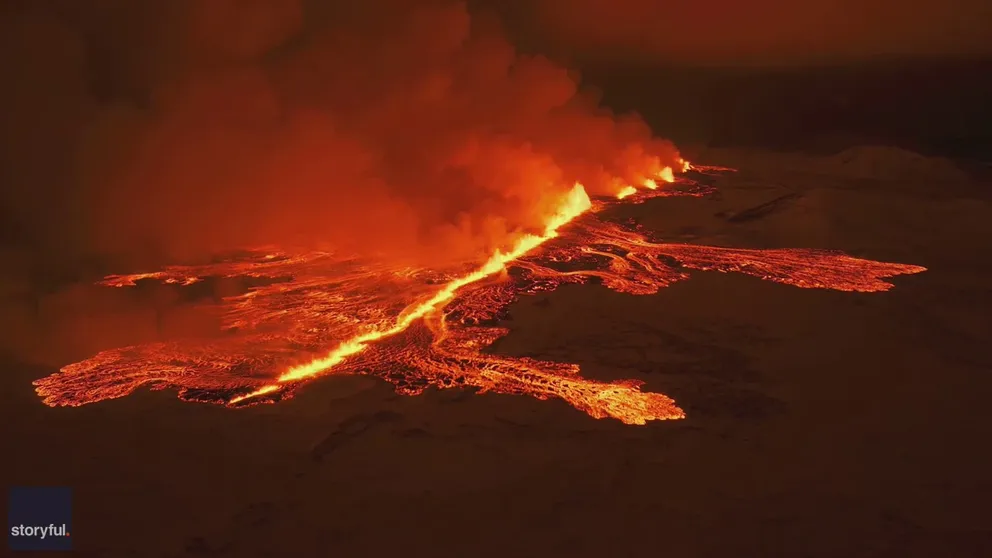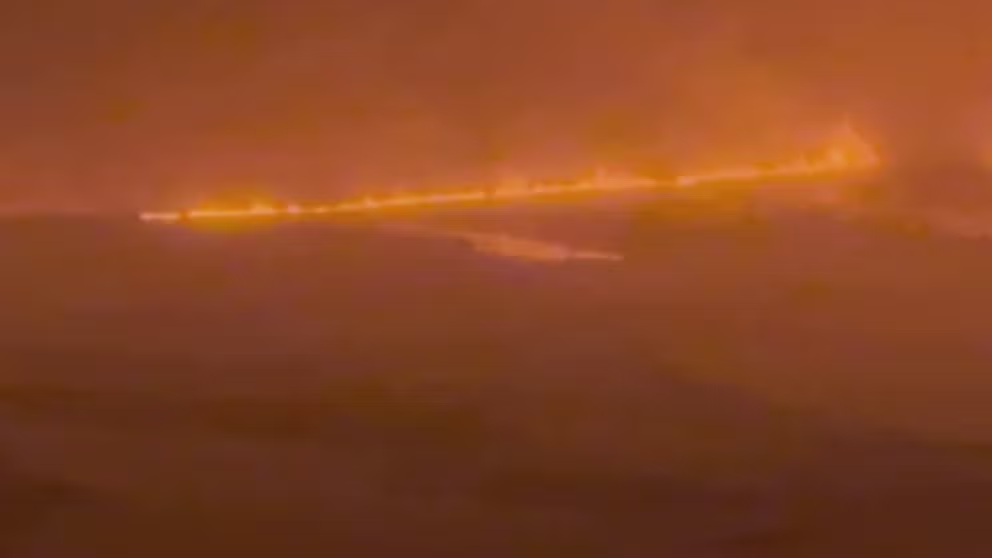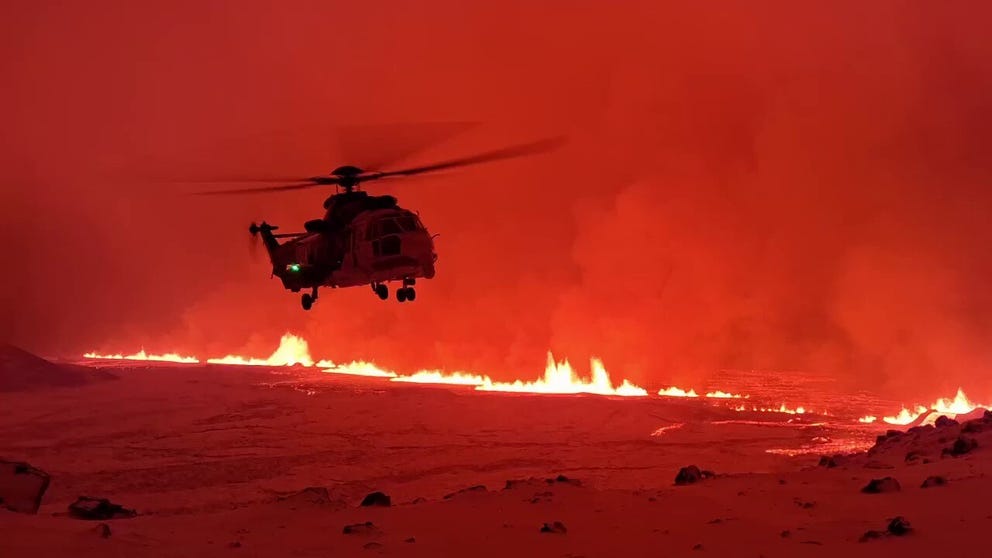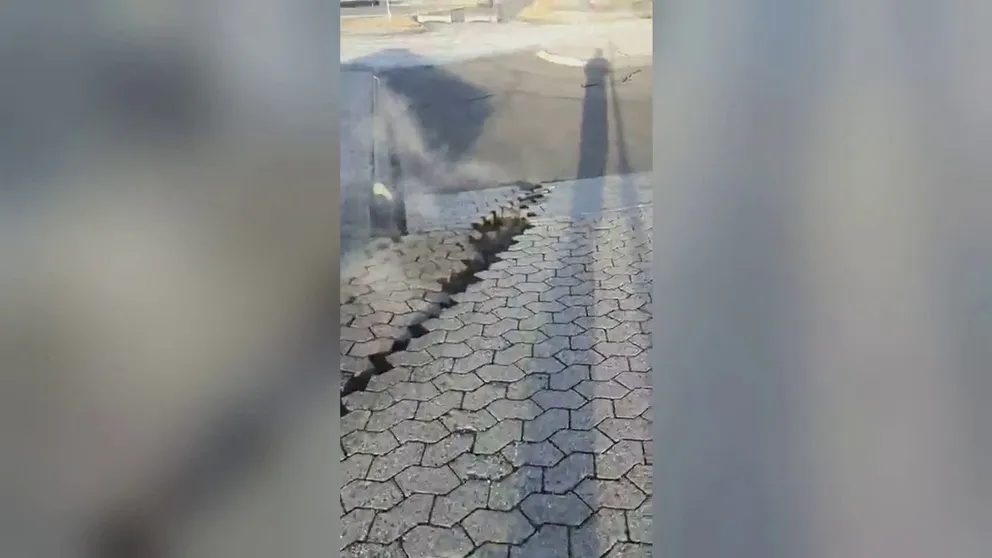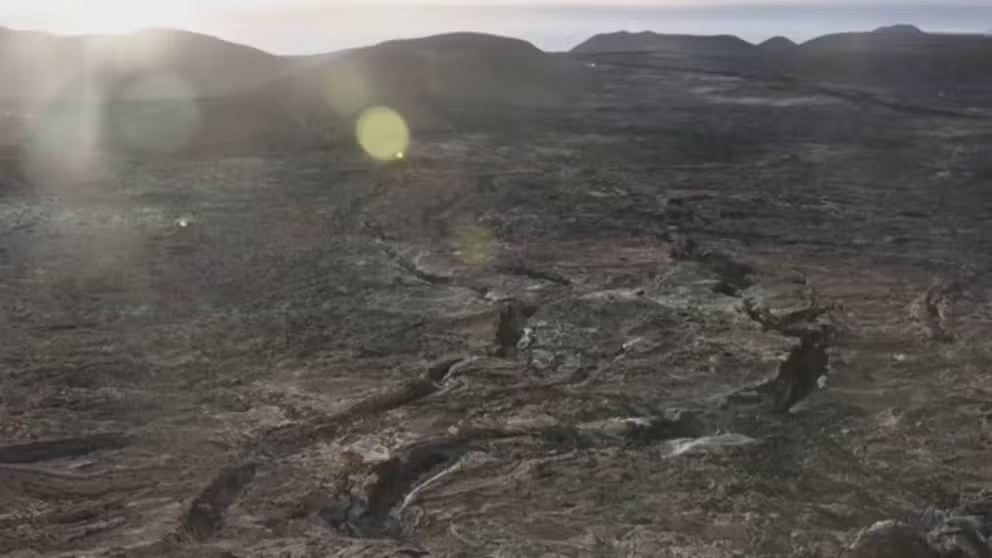Activity at Iceland volcano stops; scientists warn it's too early to declare eruption over
When news came that an eruption in the Grindavík area was likely, officials evacuated the town, the popular tourist destination Blue Lagoon was closed, and crews worked to build fortifications around critical infrastructure that would hopefully protect it from advancing lava.
Lava still flowing from Iceland volcano as eruption begins to weaken
FOX News Journalist CB Cotton joined FOX Weather on Wednesday to provide the latest details about a volcano that erupted north of the seaside town of Grindavik in Iceland earlier this week.
GRINDAVIK, Iceland – Scientists flying over the fissures of a volcano that erupted in Iceland on Monday say activity has stopped, but it’s still too early to declare an official end to the eruption.
The Icelandic Meteorological Office (IMO) said embers are still visible in the volcano’s lava bed from the air, and scientists on the ground have also confirmed that observation.

Hot embers are seen in the lava bed of a volcano that erupted in Iceland on Monday, Dec. 18, 2023.
(Icelandic Meteorological Office / FOX Weather)
The IMO said activity at the volcano seemed to have stopped late Wednesday night or early Thursday morning but warned it’s still too early to say the eruption has ended because it’s possible that magma remains just below the surface.
CAN ONE VOLCANO'S ERUPTION TRIGGER AN ERUPTION AT ANOTHER VOLCANO?
Eruption of Iceland volcano began Monday
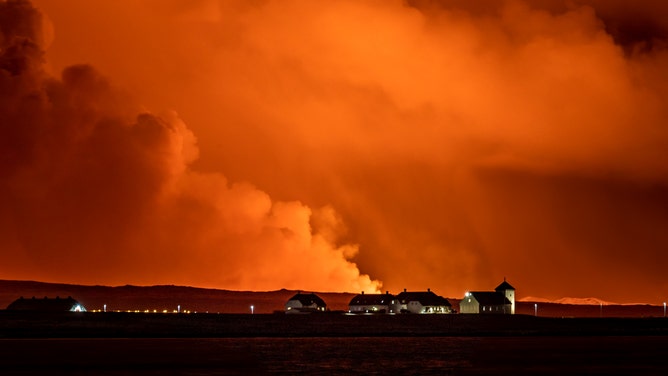
A view of the Bessastadir, the official residence of President of Iceland as volcano spews lava and smoke as it erupts in Grindavik, Iceland, December 18, 2023. (Photo by Snorri Thor/NurPhoto via Getty Images)
(Getty Images)
The volcano erupted in Iceland late Monday night about an hour after an earthquake rocked the region north of the seaside town of Grindavík, which was evacuated weeks before the Earth opened up and lava shot hundreds of feet into the air along a fissure that was about 2.5 miles long.
The explosive activity came weeks after tens of thousands of earthquakes were recorded in the area, raising concerns that an eruption was imminent.
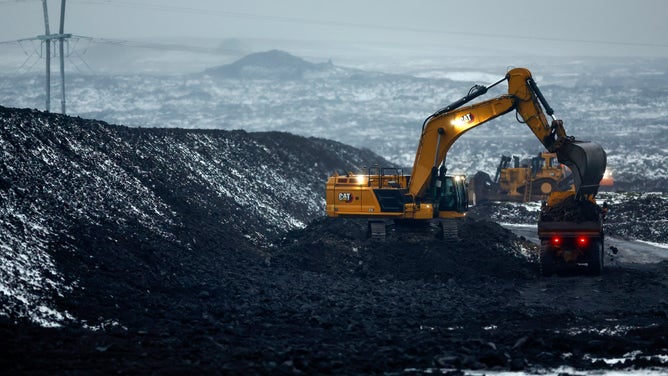
GRINDAVIK, ICELAND - DECEMBER 20: A view of the wall Icelandic authorities have built around a geothermal power plant in the country's southwest to protect it from possible lava flows on December 20, 2023 in Grindavik, Iceland. After weeks of seismic activity around Grindavik that led to the evacuation of some 4,000 residents, a volcano has erupted on the Reykjanes peninsula, with lava bursting from a crack about 3.5km long. (Photo by Jeff J Mitchell/Getty Images)
(Getty Images)
When news came that an eruption in the Grindavík area was likely, officials evacuated the town, the popular tourist destination Blue Lagoon was closed, and crews worked to build fortifications around critical infrastructure that would hopefully protect it from advancing lava.
WHAT HAPPENS BEFORE A VOLCANO ERUPTS?
Explosive activity at Iceland volcano was short-lived
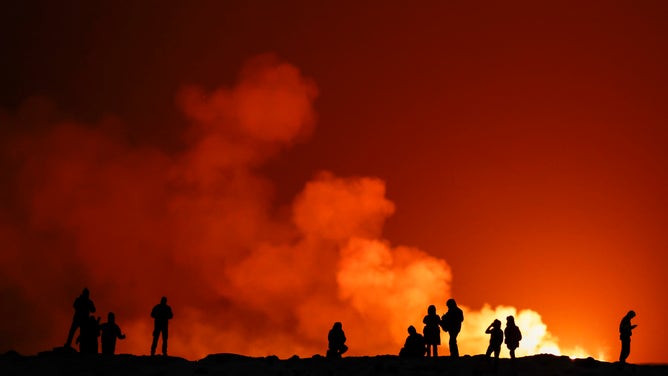
GRINDAVIK, ICELAND - DECEMBER 19: People view the volcano on the Reykjanes peninsula in south west Iceland which has erupted after weeks of intense earthquake activity/ on December 19, 2023 in Grindavik, Iceland. After weeks of seismic activity around Grindavik that led to the evacuation of some 4,000 residents, a volcano has erupted on the Reykjanes peninsula, with lava bursting from a crack about 3.5km long. (Photo by Jeff J Mitchell/Getty Images)
(Getty Images)
The power of the eruption in Iceland didn’t last long, and the IMO reported that activity along the fissure began to weaken by early Tuesday morning.
Lava that was seen in spectacular photos and video during the eruption in the Grindavík area slowed and eventually came only from a few areas along the crack.
Officials were cautious, however, and warned that although the eruption was weakening, there was still a chance that activity could again increase with little to no warning.
"Looking back to the lead-up to the eruption reveals there were approximately 90 minutes between the first indicators and the start of the eruption," the IMO said in an earlier update. "Therefore, the warning time for new vent openings at Sundhnuk could be very short."
DRONE VIDEO SHOWS LARGE CRACK SPLITTING ICELANDIC TOWN'S STREET AMID VOLCANIC THREAT
Cautious Grindavík residents allowed to return
Watch: Lava spews from volcanic fissure near Grindavik, Iceland
The Icelandic Civil Defense shared dramatic video of lava shooting from a volcanic fissure near the town of Grindavik after a volcano erupted on Monday night.
The IMO on Wednesday released a new hazard risk assessment map based on observations, which showed a reduced risk for the town of Grindavík.
Because of that assessment, officials in the area made the decision to allow residents of Grindavík to return to town starting Thursday morning, but they would need to leave the area by 4 p.m. local time due to the continued risk of a possible eruption in the area.
Watch: Drone video shows lava shooting from volcanic fissure in Iceland
Dramatic video shows lava shooting from a long fissure north of Grindavik, Iceland, late Monday night after a volcano erupted in the area.
Iceland’s public service broadcaster RÚV reported several cars had lined up at checkpoints early Thursday morning to be among the first to be allowed back into town.
Those who made the decision to return to town didn’t need to register, and they were not escorted like they were when they were allowed to briefly return home to gather belongings ahead of the eruption.
However, emergency personnel remain in town, and light and sound signals will be used to warn residents to quickly evacuate if an eruption begins.
Airline passenger captures video of Iceland eruption from the air
Watch: Airline passenger gets bird's-eye view of Iceland volcanic eruption
A tourist on a flight arriving at Iceland's Keflavik airport captured dramatic video of a volcano eruption that began near the town of Grindavík on Monday night.
Flights into and out of Iceland were not affected by the eruption, with Icelandair officials saying operations were continuing as normal at Keflavik Airport.
"The safety of our passengers and staff is always our number one priority and at the heart of every decision we make," the airline said in a statement. "We’re monitoring the situation closely and will inform our passengers of any new developments."
One airline passenger arriving in Iceland on Monday night was able to capture spectacular video of the eruption near Grindavík from the air.
The video shows the flight descending into the airport, and in the distance, lava can be seen shooting high into the air.
ICELAND RESIDENT DESCRIBED RELENTLESS EARTHQUAKES, MOMENTS OF PANICKED EVACUATION
Iceland Coast Guard investigates eruption from the air
Watch: Iceland Coast Guard gets up-close look at volcanic eruption
The Icelandic Coast Guard provided video of an up-close look at a volcano that erupted near the town of Grindavík on Monday night.
The Icelandic Coast Guard shared a video of a helicopter getting a better view of the eruption from the air.
According to a Facebook post, the Icelandic Coast Guard flew over the eruption with scientists from the country’s Department of Public Defense, the Icelandic Meteorological Office and the University of Iceland.
The Icelandic Coast Guard said in the Facebook post that scientists were hoping to better understand the magnitude of the eruption from the air.
WHAT WAS THE MOST DESTRUCTIVE VOLCANIC ERUPTION IN US HISTORY?
Grindavík's waiting game
Watch: Video shows steam rising from cracked roads in Grindavik amid Iceland volcanic eruption fears
Video recorded in Grindavik shows steam coming from cracks that formed in roads. The seaside town in Iceland is preparing for a possible volcanic eruption.
Grindavík was evacuated on Nov. 10, but a decision to let residents return to gather belongings left behind was made two days later. At that time, residents in an eastern district of Grindavík returned to gather what they could, including pets, and then retreated back to safety.
More residents in a different district were then allowed to return on the morning of Nov. 13 before all residents were told they could go back later that day.
Strict rules were in place, however. For instance, only one person per household was allowed back inside Grindavík, and only if they were accompanied by a first responder.
They were also given only about five minutes to gather what they could before they were told to leave.
Aerial views of southwestern Iceland show volcanic crater, cracks
(Video from November 2023) A volcanic eruption is possible near the region of Grindavík in Iceland. This video shows an aerial perspective of the area. (Courtesy: Reuters)
Residents who were unable to return on those days were given another opportunity on Nov. 14, but that was short-lived as gas meters in the area began to detect an increased level of sulfur dioxide, leading officials to quickly evacuate the area.
The popular tourist destination Blue Lagoon also closed its operations in early November because of fears of the volcanic eruption.
According to Iceland's national public service broadcaster RÚV, no one was at Blue Lagoon when the eruption started Monday night, and everyone had already left the area.
Blue Lagoon said on its website that the area will remain closed until at least Dec. 27, at which point the situation will be reassessed.
Guests who had reservations during that time will be contacted about the situation.

